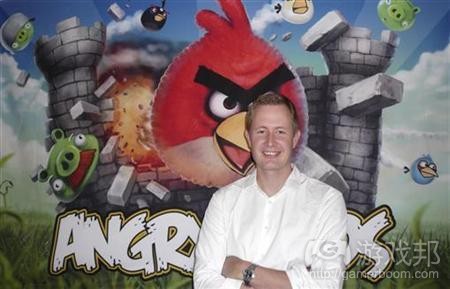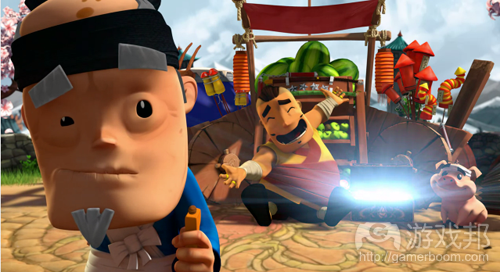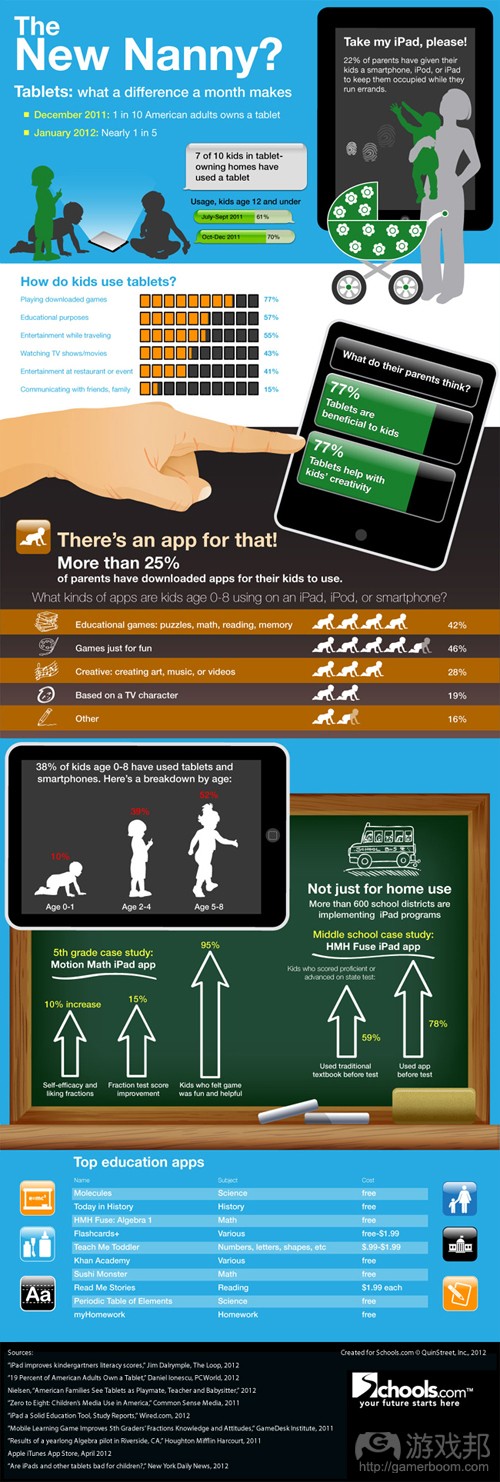每日观察:关注美国儿童的平板电脑使用情况(5.22)
1)据Arctic Startup报道,芬兰开发商Rovio在2011年财报中并没有显示与2011年融资的4200万美元相关的数据。这种情况意味着这4200万美元中的大部分资金并未用于企业建设,而是落入了现在股东的囊中。
报道指出Accel Partners和Atomico Ventures这两家主导该轮融资的投资机构现在分别享有Rovio公司10%的股份,但这20%的股份很可能是从Roivo首席执行官Kaj Hed那里所购得,Kaj Hed目前通过自己的Trema International Holdings公司享有近70%的Rovio股份——这意味着Kaj Hed先前掌握了公司近90%的股份。
Arctic Startup认为,Rovio提前数周公布财报结果有可能就是为了隐瞒之后的投资情况。
2)迪士尼最近向迪士尼商店及其网上商店推出了《Where’s My Water?》官方授权的周边产品,其中包括以Swampy、Cranky和Allie这三个鳄鱼角色为主的毛绒玩具以及电子配件,并将于6月份在大众零售市场上架。
据迪士尼所称,首批Where’s My Water?周边产品还包括服装、饰品、电子产品、文具、非手机游戏、家居饰品,并将在秋季推出万圣节服装道具等新产品。
迪士尼并非首家推出基于手机游戏周边产品的公司,Rovio游戏《愤怒的小鸟》的授权合作伙伴就已超过200家,其授权项目在2011年的1.063亿美元收益中占比达30%。
3)据TouchArcade报道,澳大利亚开发商Halfbrick日前宣布为庆祝《水果忍者》诞生两周年,他们将于5月24日推出一个更新版本。该版本将支持玩家付费购买增加能量的道具,例如获得避开炸弹,延长时间的能力。
4)据Develop报道,美国动视计划在英国成立一个新手机游戏开发工作室,并指派Team17联合创始人及行业元老Martyn Brown为该工作室招兵买马,这新工作室将享受英国政府两个月前颁布的电子游戏行业减税政策(游戏邦注:动视之前曾极力游说英国政府为游戏公司减税)。
动视此前曾与Bizarre Creations在英国利物浦运营一家工作室,该工作室规模曾一度多达200名成员,但在2011年关闭了工作室。此外动视在利明顿也有一家工作室,即《DJ Hero》开发商FreeStyleGames。
5)社交初创公司HighTable日前发布的信息图表指出,美国男性智能手机用户的移动网络使用率高于女性用户,两者所占比例分别为51.3%和48.7%。
在各年龄段用户中,25-34岁群体的移动网络使用率最高,达到25.6%,其次是35-44岁群体,所占比例为20.7%。
用户对短信功能的使用率为74.3%,社交网络的使用率为35.2%,玩游戏的比例为31.4%。
6)Schools.com最近发布的信息图表显示,有22%美国家长在处理琐事的时候,让孩子自己玩智能手机、iPad或iPod打发时间。
在2012年1月,几乎每5个美国成人中就有一者拥有平板电脑;每10个平板电脑家庭中,就有7个家庭的孩子已使用过平板电脑。
在这些使用平板电脑的少儿用户中,有77%在玩已下载的游戏,有57%将其用于学习,55%用于在旅途中的娱乐消遣。
25%以上的家长为孩子下载应用程序,在0-8岁的幼儿群体中,有42%将iPad、iPod和智能手机用来玩益智、数学、阅读和记忆等类型的教育游戏,有46%用来玩有趣的游戏,有28%用来体验画画、音乐或视频等创造性内容,19%用来体验与电视角色有关的内容。
在这些0-8岁的平板电脑与智能手机儿童用户中,0-1岁用户占比10%,2-4岁占比39%,5-8岁占比52%。
(本文为游戏邦/gamerboom.com编译,拒绝任何不保留版权的转载,如需转载请联系:游戏邦)
1)What happened to the $42 million ‘invested’ in Rovio?
by Keith Andrew
Billed at the time as an investment that would “give Rovio wings”, a little detective work has revealed the Finnish firm’s first $42 million funding round doesn’t seem to have been used to boost its production.
Arctic Startup reports a close look at Rovio’s 2011 financials reveals the funding round, originally detailed back in March 2011, doesn’t appear in its figures.
This means the vast majority of the money likely wasn’t used to build the company, but to pay existing shareholders.
Missing money
The site reveals the two firms behind the $42 million injection – Accel Partners, and Atomico Ventures – now each boast a 10 percent share in the Angry Birds studio.
It’s claimed the majority of this 20 percent share was likely purchased from chairman Kaj Hed, who via his Trema International Holdings company, now has a near 70 percent share in the company.
This means he would have previously controlled almost 90 percent of the shares.
“It seems that the reason behind publishing the company’s annual results proactively a couple of weeks earlier may be to hide the investment that never took place,” details Arctic StartUp.
“The money is clearly somewhere else and not in Rovio’s books.”
Cover up?
The discrepancy is interesting, however, if only because of Rovio’s decision to make the supposed investment public at the time.
Both Rovio CEO and co-founder Mikael Hed and Niklas Zennstroem of Atomico Ventures – who joined the company’s board as a result of the investment – went as far as to detail the impact the money would have on the studio’s future efforts.
Rovio is yet to comment on Arctic Startup’s claims, but the site states the firm’s financials plainly do not add up as things stand, with only €700,000 in new equity for the firm declared in 2011 – a mere fraction of the investment so publicly declared little over a year ago.
Of course, given that it generated tens of millions of dollars of profit in 2011, Rovio is likely to argue that it doesn’t actually need more cash in order to grow.(source: pocketgamer)
2)Where’s my merchandise? Disney taps Swampy for character goods
Kathleen De Vere
Disney Mobile is bringing the characters of Where’s My Water? from the smartphone screen to store shelves. Starting today, shoppers at official Disney Stores and DisneyStore.com will be able to buy officially licensed products featuring Swampy, Cranky and Allie the alligators.
The merchandise, which will include plush toys and electronic accessories, will be available for purchase at mass-market retailers in June. Disney Mobile general manager Bart Decrem first revealed the company was working on a line of Where’s My Water? character goods in December.
Despite the merchandising prowess of its parent company, Disney Mobile is far from the first mobile developer to branch out into merchandising — in the past six months Halfbrick, EA Popcap, Outfit7 and Zeptolab have all announced lines of merchandise based on characters first popularized in their mobile apps.
The companies are following in the footsteps of Finland’s Rovio, the first developer to prove it was feasible to turn a hit mobile game into a multi-platform entertainment empire. Earlier this month Rovio revealed its consumer products business — which includes more than 200 licensing partners responsible for everything from stuffed toys to gummy candies — was responsible for 30 percent of its total 2011 revenue of $106.3 million.
According to Disney’s press release, the first phase of Where’s My Water? merchandise will include: plush and novelty toys, consumer electronics accessories, apparel and accessories.
Electronics, stationary, non-mobile games, home accessories and a range of Halloween costumes will be available in the fall.(source:insidemobileapps)
3)Fruit Ninja celebrates two years with pudgy ninjas, pigs and power-ups
by Joe Osborne
We’d say it’s hard to believe that Fruit Ninja is two years old, but the mobile game is basically at an Angry Birds level in terms of ubiquity. Developer Halfbrick looks to celebrate the strawberry slicer’s anniversary with a fresh update, and an interesting one at that. It looks like the studio has learned a thing or two from Jetpack Joyride’s success since free-to-play, if you catch our drift.
If you don’t, what we mean is currency, or as it will be known in Fruit Ninja: Starfruits. In the new-and-improved Fruit Ninja that’s expected to launch this week, players will get to purchase new power-ups from Gutsu and Truffles, his trusty little piggy. Only Starfuits will be able to buy boosts like the ability to swat away bombs, add additional time and blow up berries, according to TouchArcade.
The shiny new Fruit Ninja is slated to be available on May 24 in a free update, and it’s exactly updates like these that has kept Fruit Ninja in the limelight for so long. If Halfbrick wants to keep it there, it will surely have to churn out new content and features, so don’t expect things to slow down any time soon. Gallagher would be so proud.(source:games)
4)Activision preparing to open new mobile studio in UK
by Eric Caoili
Activision intends to open a new mobile game development studio in the UK, a move local trade groups (TIGA, UKIE) have hailed as a “massive vote of confidence” for the country’s game industry.
The publisher has appointed Team17 (Worms) co-founder and 20-year game industry veteran Martyn Brown to find, interview, and hire talent for the planned UK studio, according to a report from local trade site Develop.
Activision previously operated a studio in Liverpool with Bizarre Creations (Geometry Wars, Blur), which employed some 200 workers, but it closed the developer in January 2011. It also owns a studio in Leamington, DJ Hero maker FreeStyleGames.
The company could take advantage of tax breaks announced for the local video game industry two months ago — Activision previously lobbied heavily for the UK government to introduce tax relief for game studios.(source:gamasutra)
5)Infographic: The power and growth of mobile marketing in the US
by Zen Terrelonge
The average campaign budget is up to $100,000.
Professional social startup HighTable is behind the infographic, which looks at the way smartphones have risen to popularity among Americans, as well as who and how they’re using them, while the mobile marketing space booms.
Males use the mobile web more than females, while 25.6 per cent of 25-34 year-olds lead for age, falling to just 6.9 per cent for 13-17 year-olds.
Meanwhile, the average mobile campaign budget is between $75,000-100,000, while the ad market generated $1.24 billion in 2011 and is set to pass $5 billion in 2015.(source:mobile-ent)
6)38 per cent of 0-8 year-olds have used tablets/smartphones
by Zen Terrelonge
Crayola and a colouring pad, Henry? No thanks, I wanna play Draw Something.
The days of children playing in the streets are fading away, as youngsters opt for digital alternatives across consoles, PCs, laptops – and now tablets, according to an infographic from Schools.com.
Almost a quarter of parents have given their child a smartphone, iPad or iPod to keep them busy during errand runs.
Gameplay is the most common child tablet use with 77 per cent and 57 per complete educational tasks, while communicating to friends and family is the least common activity on just 15 per cent.
Interestingly, 77 per cent of parents believe tablets are beneficial to kids, and the same figure reckon they help with creativity.(source:mobile-ent)












































 闽公网安备35020302001549号
闽公网安备35020302001549号